In early 2021, Lynn Edens of Snowmass Alpacas and Jason Gill of Cotton Creek Farms began using an alpaca coat color genotyping test to better understand the base colors of our alpaca herds. They hoped this data would impact our breeding decisions and the ultimate outcomes of our breeding programs. Both have been thrilled with the results, and as a bystander, it has been amazing to watch the discovery and collaboration unfold.
Their findings have made a major impact on the operations of both Snowmass Alpacas and Cotton Creek Farms. The genetic data, and the information it brings to light, has truly impacted who we breed, how we breed them, and how we present these alpacas to clients for sale.
Lynn gave an update on these efforts in a live presentation at the Parade of Champions Auction in early June. Below is a web-friendly version of this presentation. You can find the original presentation in PDF form on the Snowmass website.
Why We Decided to Test Alpaca Color Genotypes
- Individual phenotypic colors are produced by more than one genotype.
- Economic results are linked to color outcomes.
- Better knowledge about the probability of various color outcomes allows selection pressure to shift more in favor of fleece traits.
- Knowing color genotypes improves the value of our animals to other breeders.
Alpaca Base Coat Colors
- All alpaca base coat colors are produced by varying quantities of yellow/red and black pigment.
- The ASIP gene encodes a protein that regulates the production of yellow pigment, pheomelanin, by melanocytes.
- The MC1R gene encodes a protein that determines whether black pigment, eumelanin, will be produced by melanocytes.
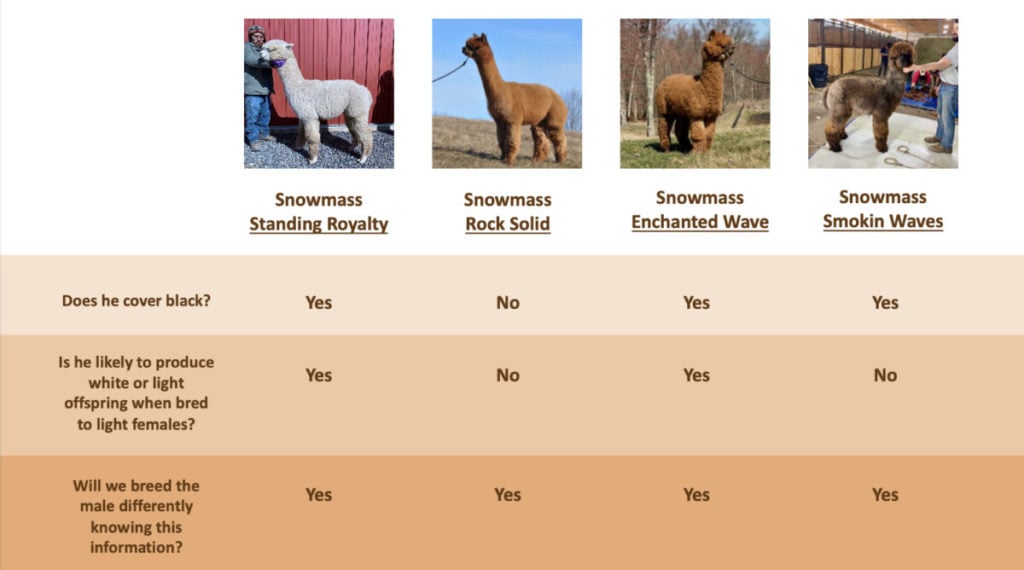
Before We Tested Our Alpacas We Thought
- There were three different “color genes”: black, brown, and white or light.
- Light was partially dominant over brown and fully dominant over black.
- An animal could also be dilute and not express any black pigment in its fleece. This dilution was a recessive genetic trait.
Our Testing Data Suggest
- There may be no white or light ASIP gene mutation. White phenotypes are produced by dilution of an ASIP genotype that otherwise would result in a brown or black animal.
- Dilution is more complex and plays a greater role in the variation of color we see than we previously thought.
Our First Sample Group
- We received results for 255 animals.
- We tested mostly dark animals in the first group because we thought results for those animals would pay for themselves first.
- The tests results revealed:
- Whether or not the animal covered black.
- Whether it carried zero, one, or two alleles for dilution (MC1R gene).
- Whether or not our animals carried a homozygous-lethal mutation for tuxedo grey (KIT gene).
Interpreting the Test Results
ASIP Gene
- “A” indicates the presence of a non-black allele.
- “a” indicates the presence of one ore more recessive mutations that result in reduced production of pheomelanin relative to eumelanin, with the outcome of a darker or black fleece.
MC1R Gene
- “E” indicates the presence of an allele that allows for the expression of eumelanin, the black pigment.
- “e” indicates the presence of of one or more mutations that result in reduced or eliminated production of eumelanin..
Grey/Non-Grey
“Grey” indicates the presence of a homozygous-lethal mutation in the KIT gene that, when a single copy is present, produces a tuxedo grey phenotype visible in animals with darker coats. It does not capture the genotype of a modern grey, or roan. It is also possible that mutations other than that tested for can produce a tuxedo grey phenotype.
Our First Observations
- Almost all whites and lights carried two dilution mutations (“ee”), which made us wonder whether there was a light or white coat allele for ASIP (or any other gene) prevalent in our herd.
- Some animals that were genotypically black were not phenotypically black. Most were brown and a few were lighter. WTH? (this is a technical term in the field of amateur genetics).
- The lighter our brown and fawn animals were, the more likely they were to carry one dilution mutation.
Wild Color
The vicuna ancestor of alpacas was probably the same color as these modern vicuna – brown with a white ventral pattern. This color is presumably the “wild type” color, represented in our test results by ”EE AA”. Over time, breeders have selected for gene mutations that produce other colors.
If the non-black ASIP ”A” test result was capturing both a brown and a lighter type ASIP mutation, we would expect see some evidence of both in the chart below. But we only see evidence that “A” represents a wild-type color. This makes it harder to argue that there is a light-type ASIP allele present in our sample group.
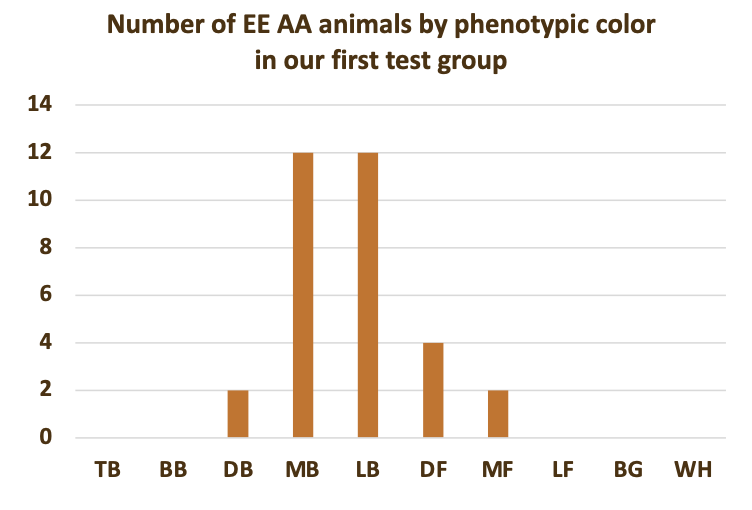
This May Be A Better Representation of ASIP Genotypes
- “Wild Type” Brown AA
- Dark Brown Aa
- Black aa

And This May Better Represent the Complex Role That The MC1R Genotype Plays
- No dilution mutations, one black mutation EE Aa.
- One dilution mutation, one black mutation Ee Aa.
- Two dilution mutations, one black mutation ee Aa.

These are tested genotypes.
Relationship Between Depth of Color and MC1R Genotypes
For most phenotypic colors, the ASIP genotypes are on average lighter for animals with no MC1R dilution mutation present than for those with one. This association was statistically significant for the phenotypic colors for which we had sufficient data in the first group.
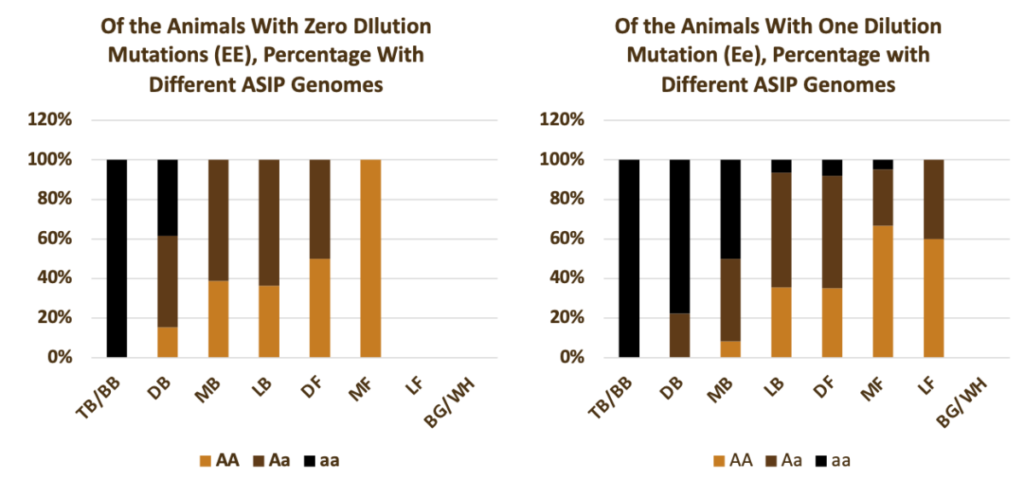
Genetic Researchers Have Found a Similar Relationship

Source:
The Alpaca Melanocortin 1 Receptor: Gene Mutations, Transcripts, and Relative Levels of Expression in Ventral Skin Biopsies Bathrachalam Chandramohan, Carlo Renieri, Vincenzo La Manna, Antonietta La Terza
Scientific World Journal. 2015; 2015: 265751. Published online 2015 Jan 5. doi: 10.1155/2015/265751
PMCID: PMC4313674
One Other Way To Look at It
Within Our First Sample Group, Percentage of Animals Carrying Zero, One, and Two Dilution Alleles by Phenotypic Color:

A Rough Guide To Expected Average Depth Of Color For Different Genotypes, Based On Our First Round Of Testing:
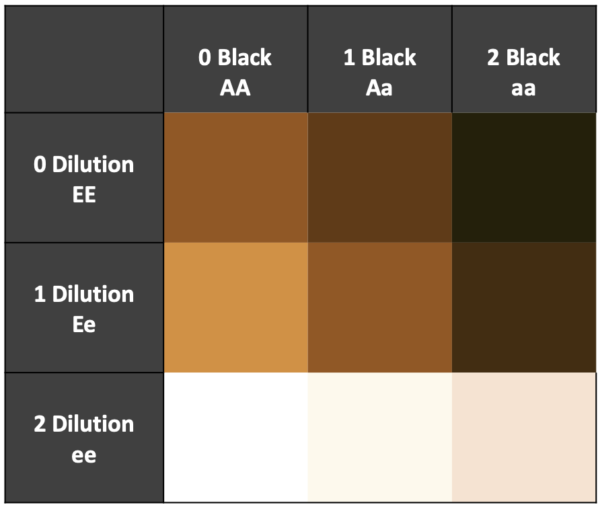
Testing Results by Colors
Blacks:
- We tested 20 true black or bay black animals. All were genotypically black (aa)
- We also found 29 animals that are genotypically black at ASIP but not phenotypically black. Most were dark or medium brown
- The most common true black and bay black genotype was Ee aa (69% of true blacks and 83% of bay blacks)
- Is there more than one type of “black” genotype?
Dark and Medium Browns:
- 67 animals tested with results
- The majority did not carry a MC1R dilution mutation. Of the ones that did, most were genetically black at ASIP (”aa”)
- All but one of the dark browns covered black
- The most common genotypes in our sample group were:
- Dark brown: Ee aa (44%)
- Medium brown: EE AA (22%)
Light Browns:
- We received results for 48 animals
- The most common genotype was Ee Aa.
- But along with medium browns, this phenotypic color was the most likely to be produced by wild/wild EE AA genotype (25% of our sample)
Fawns:
- We have results for 79 animals
- Over 80% carried one MC1R dilution mutation
- The EE AA genotype (no dilution, no black) appears in less than 10% of fawn animals
- 55% of dark fawns carried one black allele, versus 24% of medium fawns
Light Fawns:
- We only tested eight in the first round
- Six carried two MC1R dilution mutations and two carried one
- Five of the eight covered black
- While a very small test group, they looked more like whites than fawns
Whites and Beiges:
- We tested 33 in the first round (far more are coming in round 2)
- 90% carried two dilution alleles, and the ones that did not carried a single dilution allele and were genotypically black at ASIP (Ee aa)
- The fact that all almost all light animals carry two dilution alleles (ee) also suggests that in our herd the light/white phenotype may produced by dilution, not by a “white” mutation in another gene.
No Prevalent White/Light Gene Mutation?
- We can see no indirect evidence for it in our first round of testing. If it was there, we would expect white MC1R genotypes to vary more. Instead, we see that the great majority of whites and lights have two copies of the MC1R dilution mutation.
- A dilute “ee” animal may already be so light that it would be hard to independently select for a white or light genotype produced by the function of another gene or genes, making it less likely one would be prevalent.
Using this Data in the Current Breeding Season
- We will breed whites to dark animals that do not carry a copy of the MC1R dilution mutation
- We will use our whites from dark color lines more extensively in our white program
- We will provide color genotypes in the Snowmass/Accoyo America Community Database for you to use
There is Still a Lot to Learn
- Do further results confirm or contradict our hypotheses?
- Can we improve our ability to accurately guess what genotype is producing a given
phenotype? - Can we integrate the results with our pedigree analytics to help see if there is more than one type of black ASIP mutation circulating in our herd?
- Can we effectively use this information to improve our breeding results, both in terms of fleece quality and financial value?
- Can we use our data and animals to attract interested researchers to further study alpaca color genotypes?
Thank You to Participating Farms
Thank you to all the farms who have participated in the process! Your willingness to share your genotyping data has helped the alpaca industry grow in knowledge and improve our collective breeding efforts.
Participating farms include Black Barn Alpacas of Texas, Cinco C’s Alpacas of Pennsylvania, Claddaugh Farm Alpacas of New York, Cotton Creek Farms of Michigan, Fun In The Country Alpacas of Michigan, Holdfast Hilty Family Farm of Ohio, Paragon Alpacas of Maryland, Seven Acres Alpaca Farm of New York, and Snowmass Alpacas of New York.

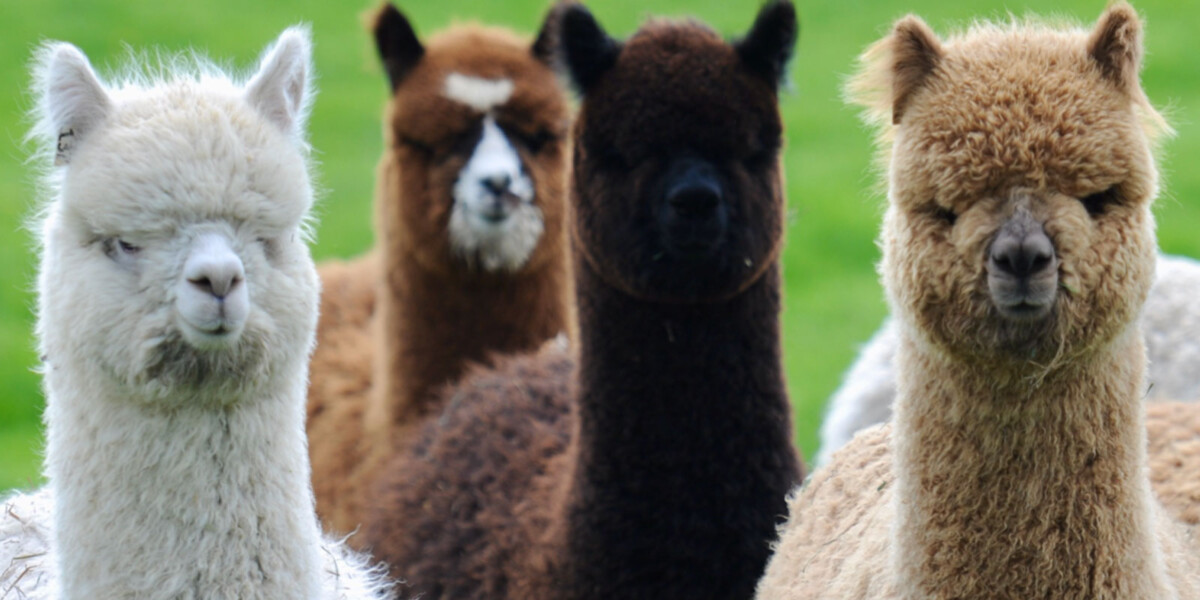

Hello we are intrested to color typing some alpacas ,we live in Belgium.
Can you tell us how it works?
What do you need ? Some fleece sample or a skin sample?
And what are the costs ?
Lots of questions ,thanks for your help!
Kind regards
Stienlet yvonne
Alpacalandgoed.
We use NeoGen in Canada for the testing. You purchase their blood cards, then send them a blood sample for analysis. Their website is https://www.neogen.com/.